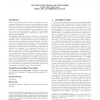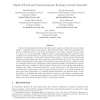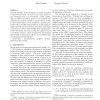856 search results - page 5 / 172 » On Randomness Measures for Social Networks. |
SOCIALCOM
2010
13 years 5 months ago
2010
The typical task of unsupervised learning is to organize data, for example into clusters, typically disjoint clusters (eg. the K-means algorithm). One would expect (for example) a...
WWW
2011
ACM
13 years 2 months ago
2011
ACM
Online social networks have become very popular in recent years and their number of users is already measured in many hundreds of millions. For various commercial and sociological...
ISAAC
2007
Springer
14 years 1 months ago
2007
Springer
Social networks support efficient decentralized search: people can collectively construct short paths to a specified target in the network. Rank-based friendship—where the prob...
SDM
2010
SIAM
13 years 8 months ago
2010
SIAM
In social networks, nodes correspond to entities and edges to links between them. In most of the cases, nodes are also associated with a set of features. Noise, missing values or ...
SDM
2008
SIAM
13 years 8 months ago
2008
SIAM
Understanding the general properties of real social networks has gained much attention due to the proliferation of networked data. The nodes in the network are the individuals and...



